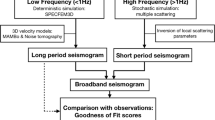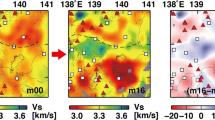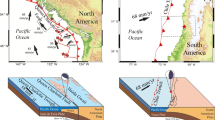Abstract
We have calculated broadband synthetic seismograms for March 11, 2011 Tohoku earthquakes using the Spectral-Element Method. We use finite source models by using a set of sub-events distributed along the fault surface, retrieved by inversion of body waves (Nakamura et al., 2010). The finite source model used in this simulation estimates Mw to be 9.1. The fault dimension is 460 km times 240 km with the source duration time of 150 s. We use the Earth Simulator2 of JAMSTEC to calculate preliminary synthetic seismograms for this finite source model. We used 726 processors of the Earth Simulator 2, which should provide synthetic seismograms that are accurate up to about 5 s and longer. The comparison of the synthetic seismograms with the observation for this event shows that synthetic P-waveforms model the observed seismogram quite well, reflecting that the finite source model is quite precise. This source model shows that the maximum slip occurs at depth of 20 km and propagates to shallower region, which is consistent with the fact that the tsunami excitation was significant for this event. Azimuthal dependence of misfits of synthetic waveforms and observation, especially for surface waves, may reflect the discrepancies of three-dimensional mantle structure used in this simulation with the actual Earth.
Access provided by Autonomous University of Puebla. Download conference paper PDF
Similar content being viewed by others
Keywords
These keywords were added by machine and not by the authors. This process is experimental and the keywords may be updated as the learning algorithm improves.
1 Tohoku Earthquake
The 2011 Tohoku earthquake (March 11, 2011, 38.322N 142.369E, depth 24 km Mw9.0 by JMA) was one of the largest earthquakes recorded during the past 100 years all over the globe. The earthquake was felt in large parts of the Japanese Islands and the huge tsunami caused serious damages to the Pacific coasts of northern part of Japanese Islands. Although the epicenter of this earthquake locates at the place of subduction of oceanic tectonic plate, where we expect to have frequent M7 or 8 class large earthquakes, there was no historical record of this size of huge earthquake in this area. This fact raises a question if there are different characteristics of the rupture mechanism of this earthquake, which marks this earthquake as a peculiar event and many researches are conducted to reveal source characteristics of this earthquake.
2 Earthquake Rupture Mechanism
We apply the waveform inversion [1, 2] to obtain slip distribution in the source fault at the 2011 Tohoku earthquake in the same manner as our previous work [3]. We use 22 broadband seismograms of IRIS GSN seismic stations with epicentral distance between 30 and 100 degrees. The broadband original data are integrated into ground displacement and band-pass filtered in the frequency band 0.002–1 Hz. We use the velocity structure model IASP91 [4] to calculate the wavefield near source and stations. We assume that the strike of the fault plane is 201 degree and the dip angle is 9 degree, based on Global Centroid Moment Tensor solution. The length of subfault used for our inversion is 30 km in the strike direction and 20 km in the dip direction. The assumed fault length is totally 460 km consistent with the aftershock distribution. The nonnegative least-squares method [5] is employed for constraining the rake angle in the waveform inversion. The strike and the total length of the source fault are illustrated in Fig. 1 with location of epicenter. We assume that rupture velocity along the fault is about 2.0 km/s. The results of the inversion show the bilateral rupture to the northeast and southwest with two main asperities along the fault; the maximum slip of 49 m with the reverse fault mechanism at approximately 100 km northeast of the epicenter and another large slip with reverse fault mechanism at 100 km southwest of the epicenter. The total amount of the released seismic moment corresponds to moment magnitude Mw = 9. 1. The slip distribution along the fault surface is also shown in Fig. 1. The duration of source time function is 150 s. The fault length of 450 km and the source duration time of 150 s are typical for Mw 9.1 earthquake. However, the maximum slip of 49 m is unusually large. Also the rupture velocity of 2.0 km/s may characterize this earthquake as slow tsunami generating earthquake. We should note that the fault rupture model, we have obtained, is not unique in the sense that the variance reduction is not significant. There are possibilities of other models, which show much slower rupture velocity or larger slip, although this result is basically consistent to other rupture models [6, 7]. Thus, we examine the validity of these fault rupture parameters by comparing the theoretical seismograms computed for this fault model with the observed seismograms.
3 Broadband Synthetic Seismograms
We calculate broadband synthetic seismograms with this source propagation model for a realistic 3D Earth model using the spectral-element method [8, 9]. We use the Earth Simulator 2 of JAMSTEC to compute synthetic seismograms using the spectral-element method. The simulations are performed on 726 processors, which require 91 nodes of the Earth Simulator 2. We use a mesh with 200 million spectral-elements, for a total of 13 billion global integration grid points. This translates into an approximate grid spacing of 2.0 km along the Earth’s surface. On this number of nodes, a simulation of 30 min of wave propagation accurate at periods of 3.5 s and longer requires about 7 h of CPU time. An example of wave propagation at the surface of the Earth is shown in Fig. 2. Also examples of waveform matches are shown in Figs. 3–5, where three component broadband seismograms are compared with the observations at teleseismic stations, AFI (Afiamalu, Samoa Islands, epicentral distance 67 degrees), ESK (Edinburgh, UK, 81 degrees), and HRV (Harvard, USA, 92 degrees). Each trace is bandpass filtered between 0.002 and 0.1 Hz. We may say that the synthetic seismograms reproduces observed seismograms generally well for body waves. Although surface waves are not modeled well, but it is because the surface waves with this period range depend on shallow crustal structure, which may not be modeled well in the 3D mantle model. Figure 6 demonstrates example of comparison in lower frequency range for station AFI and shows that the agreement is excellent in lower frequency range.
Wave propagation at the surface of the Earth. Vertical displacement at the surface is exaggerated and large amplitude regions are colored in red. Movie created from this figures is shown at following URL (http://www.youtube.com/user/jamstecchannel#p/a/u/0/j4tLFeJiAhY)
Comparisons of synthetic seismograms and observation for IRIS GSN station AFI. The synthetics and the observations are in red and black, respectively. Instrument responses are convolved to synthetics to convert them to ground velocity. Traces are EW, NS, and UD components from top to bottom, respectively. The origin of the time axis is origin time of the event and the vertical axis shows digital count. All of the traces are bandpass filtered between 500 s and 10 s
Same as Fig. 3 but for station ESK
Same as Fig. 3 but for station HRV
Figure 7 shows synthetics for near field station KSK (3.1 degree), of F-net broadband network in the coast of Tohoku region. Because of proximity of the station location to the epicenter, the displacement shows static displacement, whose pattern is consistent to the observed crustal deformation [10]. These results indicate that the synthetic seismograms computed for this finite source model reproduce observed seismograms for both near field and teleseismic stations, which suggest that this source model captures rupture properties of this earthquake.
References
M. Kikuchi, H. Kanamori, Inversion of complex body waves. III. Bull. Seismol. Soc. Am. 81, 2335 (1991).
M. Kikuchi, H. Kanamori, Note on Teleseismic Body-Wave Inversion Program. http://www.eri.u-tokyo.ac.jp/ETAL/KIKUCHI/ (2003).
T. Nakamura S. Tsuboi, Y. Kaneda, Y. Yamanaka, Rupture process of the 2008 Wenchuan, China earthquake inferred from teleseismic waveform inversion and forward modeling of broadband seismic waves. Tectonophysics. 491, 72 (2010).
B. L. N. Kennet, E. R. Engdahl, Traveltimes for global earthquake location and phase identification. Geophys. J. Int. 105, 429 (1991).
C. L. Lawson, R. J. Hanson, Solving Least Squares Problems, Prentice-Hall, New Jersey, (1974)
K. Koketsu et al., A unified source model for the 2011 Tohoku earthquake. Earth Planet. Sci. Lett. 310, 480 (2011).
S. J. Lee, B. S. Huang, M. Ando, H. C. Chiu, J. H. Wang, Evidence of large scale repeating slip during the 2011 Tohoku-Oki earthquake. Geophys. Res. Lett. 38, L19306 (2011).
D. Komatitsch, J. Ritsema, J. Tromp, The spectral-element method, Beowulf computing, and global seismology. Science 298, 1737 (2002).
S. Tsuboi, D. Komatitsch, C. Ji, J. Tromp, Broadband modelling of the 2002 Denali fault earthquake on the Earth Simulator. Phys. Earth Planet. Inter. 139, 305 (2003).
S. Ozawa et al., Coseismic and postseismic slip of the 2011 magnitude-9 Tohoku-Oki earthquake. Nature 475, 373 (2011).
Author information
Authors and Affiliations
Corresponding author
Editor information
Editors and Affiliations
Rights and permissions
Copyright information
© 2013 Springer-Verlag Berlin Heidelberg
About this paper
Cite this paper
Tsuboi, S., Nakamura, T. (2013). Source Process and Broadband Waveform Modeling of 2011 Tohoku Earthquake Using the Earth Simulator. In: Resch, M., Wang, X., Bez, W., Focht, E., Kobayashi, H. (eds) Sustained Simulation Performance 2012. Springer, Berlin, Heidelberg. https://doi.org/10.1007/978-3-642-32454-3_9
Download citation
DOI: https://doi.org/10.1007/978-3-642-32454-3_9
Published:
Publisher Name: Springer, Berlin, Heidelberg
Print ISBN: 978-3-642-32453-6
Online ISBN: 978-3-642-32454-3
eBook Packages: Mathematics and StatisticsMathematics and Statistics (R0)











